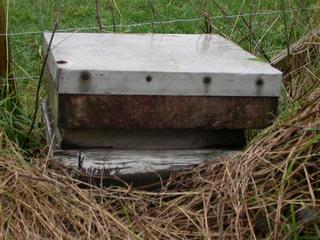 |
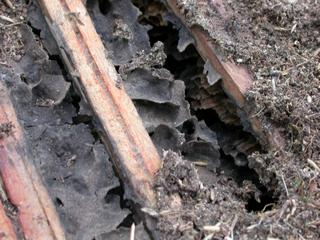 |
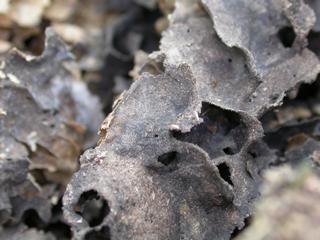 |
| The old bee hive amongst tall grass | The ant nest carton near the top of the frames with an old honeycomb inside. | |
Worcestershire Record No. 23 November 2007 pp. 35-36
Harry Green
The following edited extracts from a series of emails tell a story. The first to me from Mike Southall is dated 16th October 2007.
[from Mike Southall to Harry Green] I noticed the black ants climbing the tree on my visit [The Mitre Oak]. We have a nest of them in an old abandoned bee hive, here on the farm.
[Harry Green to Mike Southall] I am interested to know if the ants in your old bee hive are definitely Shining Black ants Lasius fuliginosus as it would be a quite unusual record. They are bigger than the commoner Black Ants of course. If you are not sure please send me a few to check!
[from Mike Southall to Harry Green] I will try and bring some to Heightington on Saturday.
[Harry Green to Mike Southall] I have looked at the ants and both those from the Mitre Oak and from your beehive key out easily to the Shining Black Ant Lasius fuliginosus. I should very much like to see the nest in the beehive quite soon if we can fix a date. This species normally builds a carton nest underneath the base of a tree and in summer the ants forage up the tree to aphids. You can see them streaming up and down the tree. The colonies do seem stable over a very long time - years. I guess we know of about ten colonies in the county and this includes the Mitre Oak which I found when the tree work was being done. According to the books, in the beginning the nest is founded in that of another species Lasius umbratus which in turn founds its colonies in Lasius niger/flavus species complexes! The chances of a founding queen hitting these circumstances must be slim and I wonder how anybody worked out an understanding of the system! Occasionally the black fuliginosus and the yellow umbratus can be seen moving about the tree together! I have never seen this. I have seen one colony apparently based in the brickwork by an old disused railway bridge near Honeybourne but all the others have been in trees. So you can see why I'm keen to see your colony. Perhaps you could suggest some dates for me to visit??
I visited Mike at Norchard Farm, Crossway Green on 21st November 2007 and he showed me an old disused bee-hive in the corner of an asparagus field. On carefully lifting the lid portions of hard brownish constructed ant nest could be seen amongst the remaining bee combs. No ants were seen in this part of the hive. Two further sections of the hive were carefully lifted showing a few Shining Black Ants certainly Lasius fuliginosus. Finally careful lifting of a flat board under the hive showed quite large clusters of ants and the entrances to many holes leading underground. The soil was bare under the hive apart from a grass stolons crossing here and there. At intervals on the stolons were small clusters of greenish aphids, visited occasionally by rather sluggish ants. The whole structure was carefully re-assembled.
 |
 |
 |
| The old bee hive amongst tall grass | The ant nest carton near the top of the frames with an old honeycomb inside. | |
[Harry Green to Mike Southall] Many thanks for showing me the ant-hive! The snippet of plant I took showed a nice colony of aphids which I have photographed. It would be useful to know what the plant was. I meant to check at the time but then forgot! I think they may have been grass runners or stolons with roots going down at intervals but I'm not sure. I don't like disturbing the ants too much and letting them get cold but maybe you will have a chance to try and identify the plant a some stage or at least check whether it's grass or not. I know various ants cultivate root aphids.
[from Mike Southall to Harry Green] I had a look at the roots this morning, and some aphids are definitely on the roots of couch grass or scutch Agrypyron repens as it is more commonly known around here. There is also a nettle growing close to the box whose roots may have been used as well. I didn't want to pull at them too much as the ants seemed to be more active this morning.
[Harry Green to Mike Southall] Thanks for yours. I thought that would probably be the answer. Here is the email I sent to Roger Umpelby and his reply. It agrees as well! My pics of the ant clusters were badly out of focus. I was careless and should have used flash though I suspect the autofocus misbehaved. I'll have another go later but wouldn't like to disturb them again for a while!
[email Harry Green to Roger Umpelby] I was shown an unusual nest of the Shining Black Ant Lasius fuliginosus today. It's scarce in the county and usually based in old trees with nests partly constructed of carton deep under the base of the tree. These colonies seem to go on for years. The one I saw today had taken over an old and partly derelict beehive and the ants were wintering in big clusters under the base flat on the ground with tunnels into the ground. A sort of artificial tree! I think they must have lost their original tree when a nearby hedge was cleared. Running near the ant clusters were long stems or stolons (or whatever) of a plant and here and on these were small aphid colonies. I saw ants visit them now and then but they are of course pretty sluggish at the moment. I brought a stolon snippet home and have pictures of the aphids. I think the plant must have been coarse grass but forgot to check and will follow it up. I attach a few so-so pics. Unfortunately my pics of the big ant clusters are blurred. Have you any comment of a suggestion for the aphid ID??
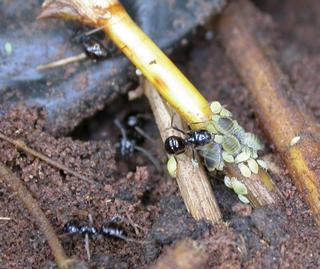 |
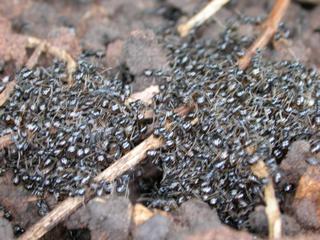 |
| Lasius fuliginosus visiting aphids on a stolon, and in a dense cluster beneath the hive | |
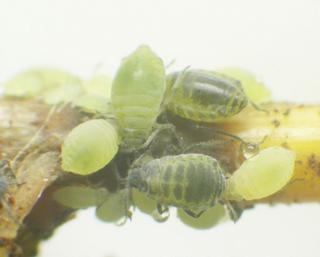 |
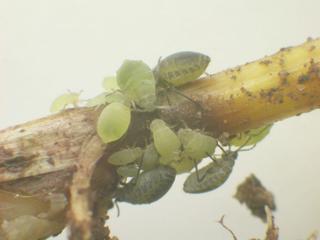 |
| Aphids on Argyron repens stolons beneath the hive. Probably Anoecia corni - see text | |
[reply from Roger Umpelby to Harry Green] There are two main genera of root aphids on grasses (I suspect the stolon was Agropyron repens, couch grass) Anoecia and Tetraneura, both of which are ant-attended. I don’t have keys for them, but I am pretty certain that the aphids are Anoecia corni. This species can live all the year round on grass roots, but can also migrate to dogwood for the sexual winter generation. The piece below confirms the association with Lasius spp. although L. fuliginosus isn’t specifically mentioned:-
The number of ants associated with a given species of aphid and the number of aphid species associated with a given species of ant varies from place to place, up to 17 different aphid species have been found in Lasius niger nests. Sometimes different ant species which live in similar habitats will foster different aphid species, i.e. Lasius niger with Anoecia corni and Lasius flavus with Anoecia nemoralis.
[to Roger Umpelby from Harry Green] Many thanks for your reply re ants and aphids. Mike checked the nest and confirmed your suggestion re the grass (I thought that would be the answer!). I have sent you separately a press release Brett Westwood sent me some time ago. I may have sent it to you when we were discussing the Willow aphids
The Press release from Buglife follows! The converse of its story is not true! However it provides an amusing aside to the paragraphs above and to Roger Umpelby’s article elsewhere in this issue of Worcestershire Record.
It’s the world’s largest aphid, fiercely guarded by ants and milked like a dairy cow. Now the public is being asked to take part in the first ever Giant Aphid Hunt.
There are almost six hundred species of aphids in Britain. Most of them are harmless to gardeners, and many are extremely rare. The Giant oak aphid (Stomaphis quercus) is one such aphid. The size of a coffee bean, the aphid feeds solely on the trunk of the English oak tree. Now wildlife charity Buglife is asking the public to look for this elusive insect.
The Giant oak aphid lives in a fascinating mini-world: it has its very own bodyguard, the Jet black ant Lasius fuliginosus, and is never found without it. The ants protect the aphids from predators such as birds in return for drops of honeydew – they literally milk the aphids as protection money. They even take the aphids into their nest in the winter. Experts believe that the ants carry the aphids high up the tree in spring and down to the base of trunk in autumn, rather like Alpine shepherds with their flocks of sheep.
Like many invertebrates the Giant oak aphid is very rare and therefore may be in danger of disappearing altogether. The aphid is only known from five sites in the UK, with a stronghold in the east of England, particularly the Norfolk Brecks. It has also been found near Colchester and Exeter, and may occur in other areas.
According to Buglife’s Jamie Roberts, ‘This survey will enable us to discover just how rare the Giant oak aphid is. When we have a comprehensive map of sites we will be able to develop measures to conserve this world-beating insect.’
Bugs are critically important to the planet, and without them life on earth would collapse. At least 65% of all species are bugs, providing us with food and ecological, agricultural, medical and technological benefits. Bugs are essential food to birds and mammals, they pollinate our crops and they help to purify our water.
---- ENDS ----
Notes to Editors:
Buglife - The Invertebrate Conservation Trust is the first organisation in Europe devoted to the conservation of all invertebrates, and we are passionately engaged in saving Britain's rarest bugs, butterflies, snails, bees, ants, spiders, worms, beetles and many more fascinating creatures. Set up in 2000, the charity now has nine members of staff working on diverse projects including bumblebee surveys and brownfield site conservation. More information can be found on our website: www.buglife.org.uk
How to take part in the Giant Aphid Hunt
Survey forms can be downloaded from www.buglife.org.uk The Hunt runs from Wednesday 8th August until the end of September. Visit oak woodland and take a close look at trees at the edge of woodland or that stand alone (the aphid doesn’t like the shade).
The Giant oak aphid is currently being studied by Graham Hopkins at the University of East Anglia. Records should be submitted to hopkins@fireflyuk.net
This project is supported by The British Entomological and Natural History Society.
For further information please contact:
Jamie Roberts
Biodiversity Projects Manager, Buglife - Invertebrate Conservation Trust,
170A Park Road, Peterborough PE1 2UF. 01733 201 210
jamie.roberts@buglife.org.uk
| WBRC Home | Worcs Record Listing by Issue | Worcs Record Listing by Subject |